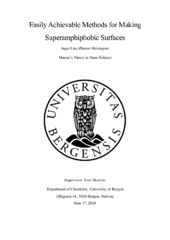| dc.description.abstract | Superamphiphobic materials have surfaces that display a contact angle above 150° for both low and high-tension liquids [1]. Superamphiphobic surfaces present exciting and innovative properties for commercial and industrial applications. Fabrication of superamphiphobic surfaces often require advanced techniques and chemicals. Easier and cheaper methods for making these surfaces are desirable to produce them sustainably, durably and on a big-scale. In this thesis, we explore whether surfaces of different materials can be rendered superamphiphobic in an environmentally sound way and with easily accessible chemicals and instruments found in most labs. Three different techniques described in the literature were taken as starting points for the pursuit of easily accommodable methods. For the first technique, glass and stainless steel substrates were dip-coated in a waterborne coating system consisting of a fluorinated compound and silica particles, to give the proper structured surfaces for superamphiphobicity [2]. In the second technique, thermal treatment was used on silicon oil to produce a layer of soot which deposited directly on to glass and steel substrates to give the proper surface structure and composition for superamphiphobicity [3]. Thirdly, aluminum was etched in hydrochloric acid in order to give a micro structured surface. The aluminum was then immersed in a solution of HNO_3 and CuSO_4 in order to provide a hierarchical structure by the addition of copper particles, and dip-coated in a fluorinated solution to minimize the surface energy [4]. The unmodified and modified substrates were characterized by electron microscopy imaging and elemental analysis to elucidate the structure and composition of the surfaces. The wetting properties and apparent surface energy of the substrates were determined from optical contact angle measurements. Superhydrophobic surfaces were readily achieved for all the tested materials. Oleophobicity was not achieved without the addition of fluorinated compounds, and none of the methods chosen yielded superamphiphobic surfaces. The easily achievable methods have not provided surface structures of the necessary quality to uphold superamphiphobicity. | en_US |
